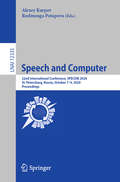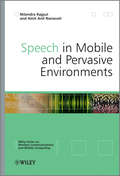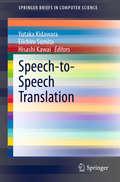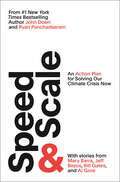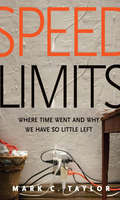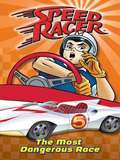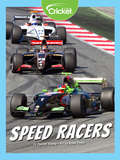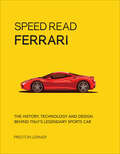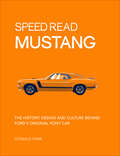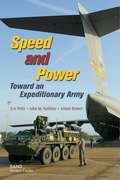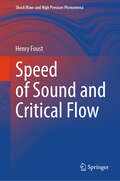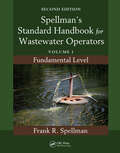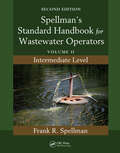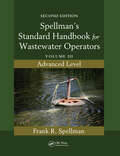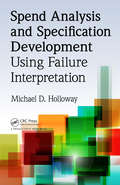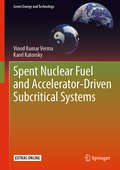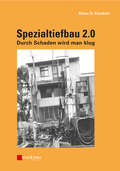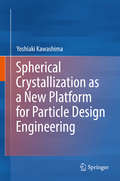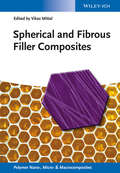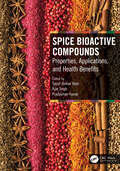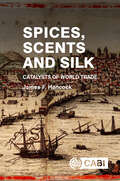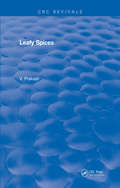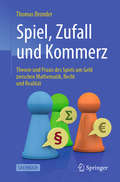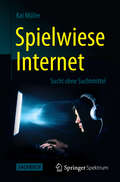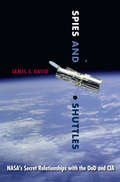- Table View
- List View
Speech and Computer: 22nd International Conference, SPECOM 2020, St. Petersburg, Russia, October 7–9, 2020, Proceedings (Lecture Notes in Computer Science #12335)
by Rodmonga Potapova Alexey KarpovThis book constitutes the proceedings of the 22nd International Conference on Speech and Computer, SPECOM 2020, held in St. Petersburg, Russia, in October 2020. The 65 papers presented were carefully reviewed and selected from 160 submissions. The papers present current research in the area of computer speech processing including speech science, speech technology, natural language processing, human-computer interaction, language identification, multimedia processing, human-machine interaction, deep learning for audio processing, computational paralinguistics, affective computing, speech and language resources, speech translation systems, text mining and sentiment analysis, voice assistants, etc.Due to the Corona pandemic SPECOM 2020 was held as a virtual event.
Speech in Mobile and Pervasive Environments
by Amit Anil Nanavati Nitendra RajputThis book provides a cross-disciplinary reference to speech in mobile and pervasive environmentsSpeech in Mobile and Pervasive Environments addresses the issues related to speech processing on resource-constrained mobile devices. These include speech recognition in noisy environments, specialised hardware for speech recognition and synthesis, the use of context to enhance recognition and user experience, and the emerging software standards required for interoperability. This book takes a multi-disciplinary look at these matters, while offering an insight into the opportunities and challenges of speech processing in mobile environs. In developing regions, speech-on-mobile is set to play a momentous role, socially and economically; the authors discuss how voice-based solutions and applications offer a compelling and natural solution in this setting.Key FeaturesProvides a holistic overview of all speech technology related topics in the context of mobilityBrings together the latest research in a logically connected way in a single volumeCovers hardware, embedded recognition and synthesis, distributed speech recognition, software technologies, contextual interfacesDiscusses multimodal dialogue systems and their evaluationIntroduces speech in mobile and pervasive environments for developing regionsThis book provides a comprehensive overview for beginners and experts alike. It can be used as a textbook for advanced undergraduate and postgraduate students in electrical engineering and computer science. Students, practitioners or researchers in the areas of mobile computing, speech processing, voice applications, human-computer interfaces, and information and communication technologies will also find this reference insightful. For experts in the above domains, this book complements their strengths. In addition, the book will serve as a guide to practitioners working in telecom-related industries.
Speech-to-Speech Translation (SpringerBriefs in Computer Science)
by Yutaka Kidawara Eiichiro Sumita Hisashi KawaiThis book provides the readers with retrospective and prospective views with detailed explanations of component technologies, speech recognition, language translation and speech synthesis.Speech-to-speech translation system (S2S) enables to break language barriers, i.e., communicate each other between any pair of person on the glove, which is one of extreme dreams of humankind.People, society, and economy connected by S2S will demonstrate explosive growth without exception.In 1986, Japan initiated basic research of S2S, then the idea spread world-wide and were explored deeply by researchers during three decades.Now, we see S2S application on smartphone/tablet around the world.Computational resources such as processors, memories, wireless communication accelerate this computation-intensive systems and accumulation of digital data of speech and language encourage recent approaches based on machine learning.Through field experiments after long research in laboratories, S2S systems are being well-developed and now ready to utilized in daily life.Unique chapter of this book is end-2-end evaluation by comparing system’s performance and human competence. The effectiveness of the system would be understood by the score of this evaluation.The book will end with one of the next focus of S2S will be technology of simultaneous interpretation for lecture, broadcast news and so on.
Speed & Scale: An Action Plan for Solving Our Climate Crisis Now
by John Doerr#1 bestselling author and acclaimed venture capitalist John Doerr reveals a sweeping action plan to conquer humanity&’s greatest challenge: climate change.In 2006, John Doerr was moved by Al Gore&’s An Inconvenient Truth and a challenge from his teenage daughter: &“Dad, your generation created this problem. You better fix it.&” Since then, Doerr has searched for solutions to this existential problem—as an investor, an advocate, and a philanthropist. Fifteen years later, despite breakthroughs in batteries, electric vehicles, plant-based proteins, and solar and wind power, global warming continues to get worse. Its impact is all around us: droughts, floods, wildfires, the melting of the polar ice caps. Our world is squarely in a climate crisis and on the brink of a climate disaster. Yet despite our state of emergency, climate change has yet to be tackled with the urgency and ambition it demands. More than ever, we need a clear course of action. What if the goal-setting techniques that powered the rise of today's most innovative organizations were brought to bear on humanity's greatest challenge? Fueled by a powerful tool called Objectives and Key Results (OKRs), SPEED & SCALE offers an unprecedented global plan to cut greenhouse gas emissions before it&’s too late. Used by Google, Bono&’s ONE foundation, and thousands of startups the world over, OKRs have scaled ideas into achievements that changed the world. With clear-eyed realism and an engineer&’s precision, Doerr identifies the measurable OKRs we need to reduce emissions across the board and to arrive by 2050 at net zero—the point where we are no longer adding to the heat-trapping carbon in the atmosphere. By turns pragmatic and inspiring, SPEED & SCALE intersperses Doerr&’s wide-ranging analysis with firsthand accounts from Jeff Bezos, Christiana Figueres, Al Gore, Mary Barra, Bill Gates, and other intrepid policy leaders, entrepreneurs, scientists, and activists. A launchpad for those who are ready to act now, this book is geared to leaders in every walk of life. With a definitive action plan, the latest science, and a rising climate movement on our side, we can still reach net zero before it is too late. But as Doerr reminds us, there is no more time to waste.
Speed Limits: Where Time Went and Why We Have So Little Left
by Mark C. TaylorA contemplation on &“the durability of our fast-tracked, multitasked modern world . . . a stimulating cautionary report for the digital age.&”—Kirkus Reviews We live in an ever-accelerating world: faster computers, markets, food, fashion, product cycles, minds, bodies, kids, lives. When did everything start moving so fast? Why does speed seem so inevitable? Is faster always better? Drawing together developments in religion, philosophy, art, technology, fashion, and finance, Mark C. Taylor presents an original and rich account of a great paradox of our times: how the very forces and technologies that were supposed to free us by saving time and labor now trap us in a race we can never win. The faster we go, the less time we have, and the more we try to catch up, the farther behind we fall. Connecting our speed-obsession with today&’s global capitalism, he composes a grand narrative showing how commitments to economic growth and extreme competition, combined with accelerating technological innovation, have brought us close to disaster. Psychologically, environmentally, economically, and culturally, speed is taking a profound toll on our lives. By showing how the phenomenon of speed has emerged, Taylor offers us a chance to see our pace of life as the product of specific ideas, practices, and policies. It&’s not inevitable or irreversible. He courageously and movingly invites us to imagine how we might patiently work towards a more deliberative life and sustainable world. &“With panache and flashes of brilliance, Taylor, a Columbia University religion professor and cultural critic, offers a philosophically astute analysis of how time works in our era.&” —Publishers Weekly
Speed Racer (The Most Dangerous Race #5)
by Chase WheelerDuring the Big Alpine Race, Speed Racer goes head-to-head against the amazing Car Acrobatic Team and the evil Capt. Terror. Both opponents plan on winning at all costs...
Speed Racers
by Rachel YoungHave you ever watched a race car take a pit stop? Learn about all of the different jobs members of the pit crew have. The pit crew does everything from change the tires of a race car to refilling the gas tank, all faster than you can count to ten!
Speed Read Ferrari: The History, Technology and Design Behind Italy's Legendary Sports Car (Speed Read)
by Preston LernerThis beautifully designed and illustrated essential guide to Ferrari celebrates the world’s premier performance-car manufacturer.From the first complete car Enzo Ferrari constructed in 1940—the Auto Avio Costruzioni—to masterpieces produced by the company today, award-winning author Preston Lerner’s Speed Read Ferrari: The History, Technology and Design Behind Italy’s Legendary Sports Car covers fifty-plus aspects key to understanding Ferrari’s amazing history, including both racing and production cars, design and technology, and the personal histories of key figures.In sections divided by topic, you’ll explore the story of Ferrari’s founding; descriptions and critiques of over twenty-five different Ferrari models, including the milestone racers, lust-inspiring road cars, and dominating F1, sports, and prototype racecars; profiles of the most famous Ferrari drivers; recaps of Ferrari’s most memorable racing wins; and a survey of all the stylists, coachbuilders, engineers, salesmen, and executives who have contributed to Ferrari’s success. Each section ends with a glossary of related terms, and informational sidebars provide fun facts, historical tidbits, and sleek illustrations of the cars that bring the evolution of the company to life.
Speed Read Mustang: The History, Design and Culture Behind Ford's Original Pony Car (Speed Read #4)
by Donald FarrMotorbooks' Speed Read series celebrates every aspect of the original pony car—the Ford Mustang—from the key people like Lee Iacocca and Carroll Shelby to the racing success to the cars themselves. Get a full look at every iconic Mustang model, from the first car to bear the name that became the fastest selling car of all time, to the astounding 526-horsepower supercar Mustang produces today. In sections divided by topic, you'll explore the design and launch of the first Mustang at the 1964 World's Fair; a history of every generation of Mustang; the various body styles, options, and accessories; a review of the performance models; a profile of Carroll Shelby and the Mustangs he designed; special editions, like the Sprint, ASC/McLaren, and police pursuit vehicles; and, of course, the Mustang's racing legacy. Each section ends with a glossary of related terms, and informational sidebars provide fun facts, historical tidbits, and mini-bios of key people in Mustang history. Sleek illustrations showcase Mustangs in their many forms. With Motorbooks’ Speed Read series, become an instant expert in a range of fast-moving subjects, from Formula 1 racing to the Tour de France. Accessible language, compartmentalized sections, fact-filled sidebars, glossaries of key terms, and event timelines deliver quick access to insider knowledge. Their brightly colored covers, modern design, pop art–inspired illustrations, and handy size make them perfect on-the-go reads.
Speed and Power
by John Halliday Eric Peltz Aimee BowerUsing a case study based on the Army's new Stryker Brigade Combat Team, the authors explore how the Army might improve its ability to contribute to prompt, global power projection, that is, strategically responsive early-entry forces for time-critical events. The authors examine options to reach a dual goal: to initiate deployment of the right force capabilities, and then get those capabilities where they need to be as quickly as possible.
Speed of Sound and Critical Flow (Shock Wave and High Pressure Phenomena)
by Henry FoustThis book focuses on two related topics in fluid mechanics, that is, speed of sound through various media and critical flow associated with gas–liquid flows. The first part of the book explores the speed of sound in liquids, gases, and solids. For gas flows, both real gas behavior and two-phase flow are reviewed; a thorough review is given of cubic equations of state. For media of solid, transverse and longitudinal waves are discussed and related back to earlier work on acoustics and gas dynamics. The second part of the book focuses on critical flow. Beginning with ideal, perfect gases, it goes into van der Waals and other equations of state. A general discussion of gas–liquid flows is subsequently given with necessary nomenclature consistent with the work of Wallis, and lastly goes on to explore critical flow for two-phase and binary mixtures through Henry and Fauske's work and the Omega method by Leung.
Spellman's Standard Handbook for Wastewater Operators: Volume I, Fundamental Level, Second Edition
by Frank R. SpellmanRetaining the same successful and proven format used in the bestselling first edition, Spellman's Standard Handbook for Wastewater Operators: Volume I, Fundamental Level, Second Edition contains the necessary information to successfully study for and pass currently administered certification examinations. Primarily designed to provide a readily acc
Spellman's Standard Handbook for Wastewater Operators: Volume II, Intermediate Level, Second Edition
by Frank R. SpellmanUp to date and current with the latest technology, Spellman's Standard Handbook for Wastewater Operators: Volume II, Intermediate Level, Second Edition provides a study guide and resource in a compact format. This second of three volumes contains a compilation of wastewater treatment information, data, operational material, process control procedur
Spellman's Standard Handbook for Wastewater Operators: Volume III, Advanced Level, Second Edition
by Frank R. SpellmanCompact and practical, Spellman's Standard Handbook for Wastewater Operators: Volume III, Advanced Level, Second Edition rounds out the revision of this three-volume set. Together, these three volumes prepare operators to obtain licensure and operate wastewater treatment plants properly. This volume presents applied math and chemistry by way of rea
Spend Analysis and Specification Development Using Failure Interpretation
by Michael D. HollowayConsidering that the biggest machines that do the most work are made up of smaller machines and components, it becomes obvious that when a large machine breaks, it is normally due to small components acting antagonistically. Detailing a time-tested method for increasing productivity and lowering operational costs, Spend Analysis and Specification Development Using Failure Interpretation explains how to establish performance-based procurement specifications for the components, devices, and items that contribute the most to operational downtime and repair/replacement costs. The book emphasizes the critical need to perform both spend and failure analysis in order to develop a procurement document, which will ultimately reduce overall costs. Accompanied by downloadable resources with helpful material such as, specification checklists, case study worksheets, form letters, and return on investment (ROI) worksheets that you can customize to your needs, the text discusses how to: Identify the products that will cost the most if they fail Develop performance-based procurement specifications to reduce direct and indirect costs Examine cost analysis as it relates to operations, maintenance, and production Determine effective criteria based on properties, test results, and standards for each operation Written by an industry expert with decades of experience giving seminars, training customers and associates, and authoring numerous papers and articles, the text provides the real-world understanding of the influential components and materials’ physical properties needed to engage in effective failure and spend analysis. It addresses product submission and monitoring and includes helpful tools so you can immediately get started on conducting your own cost-saving analysis.
Spent Nuclear Fuel and Accelerator-Driven Subcritical Systems (Green Energy and Technology)
by Vinod Kumar Verma Karel KatovskyThis book offers a comprehensive overview of the reprocessing of spent nuclear fuels, and discusses the applications of radiation, particularly spallation neutrons and gamma rays. The unspent nuclear fuel of a reactor amounts to roughly 95 per cent of the loaded fuel. It contains both fertile and fissile fuels, minor and higher actinides and radioactive fission products. In 2015, out of approximately 4 million metric tons of spent fuel, only 90,000 metric tons was reprocessed worldwide; the rest was either sent to repositories, kept for cooling down, or put on a waiting list for future reprocessing. With regard to the direct reutilization of spent nuclear fuel, the new technique of ‘Energy Amplifiers’ has attracted considerable attention among the nuclear energy community. Presenting extensive information on this technique, the book is divided into eight major sections: (i) spent nuclear fuel and alternative transmutation methods, (ii) general concept of accelerator-driven subcritical systems (ADSS), (iii) spallation neutron sources and the possibility of incineration, (iv) requirements for nuclear data, (v) transmutation of spent nuclear fuel and extension of the fuel cycle, (vi) spallation neutron production facilities, (vii) major experimental facilities for ADSS, and (viii) software tools for the design and modelling of ADSS. The book is ideally suited as a textbook for graduate students as well as a reference guide for researchers and practitioners.
Spezialtiefbau 2.0: Durch Schaden wird man klug
by Klaus D. KluckertDer Autor zeigt anhand eigener Erlebnisse aus seinem Berufsleben als Ingenieur im operativen Geschäft und als Sachverständiger typische Fehler im Spezialtiefbau auf, analysiert deren Ursachen und zeigt Wege zur Beseitigung auf. Mit diesem "etwas anderen Lehrbuch" fasst er sein gespeichertes Wissen zusammen und lässt dabei Kollegen, Berufsanfänger und Studenten an seinem wertvollen Erfahrungsschatz teilhaben. Das Buch soll helfen, den einen oder anderen Fehler mit seinen mitunter gravierenden persönlichen und finanziellen Konsequenzen zu vermeiden und dadurch auch die Unfallgefahren zu minimieren.
Spherical Crystallization as a New Platform for Particle Design Engineering
by Yoshiaki KawashimaThis book describes the principles and applications of the spherical crystallization technique, from the standpoint of its inventor. After an introduction on the history of particle design engineering and nanotechnology, the concept of spherical crystallization itself is clearly explained. Attention then turns to the application of spherical crystallization in pharmaceutical processes. It is explained how the technique can provide physicochemical properties suitable for direct tableting of active pharmaceutical ingredients and how it has enabled the development of a novel particulate design platform from single to complex system. Subsequent chapters describe the roles of polymeric spherical crystallization in the preparation of novel microspheres, microballoons for drug delivery systems (DDS) and the development of biocompatible and biodegradable poly(D,L-lactide-co-glycolide) (PLGA) nanospheres. The various applications of PLGA nanospheres composite within oral-, pulmonary-, transdermal DDS and cosmetics are fully discussed. Finally, future perspectives are presented on use of the technology in the design and industrial-scale manufacture of new drug delivery systems, highlighting how a continuous pharmaceutical process that meets US Food and Drug Administration quality requirements should soon be introduced.
Spherical and Fibrous Filler Composites
by Vikas MittalScrutinizing various fillers, such as fly ash, inorganic nanoparticles, Kevlar and wood flour, this book exemplifies how the choice of filler influences the micro- and macroscopic behavior of the resulting polymer composites, such as friction, wear and impact resistance. In so doing, the text brings together a number of composite systems using different polymer matrices, different filler systems as well as different processing conditions, thereby serving as a beneficial guide for readers so as to select a particular set of processing conditions or composite constituents for the enhancement of certain properties.
Spice Bioactive Compounds: Properties, Applications, and Health Benefits
by Ajay Singh Sajad Ahmad Wani Pradyuman KumarNature offers us spices, which are a significant part of healthy and nutritious foods. The presence of abundant bioactive compounds in these spices makes them interesting from a scientific and health perspective. Extracts obtained from spice materials possess many health benefits and are rich sources of antioxidants, which suppress reactive oxygen species. Spice Bioactive Compounds: Properties, Applications, and Health Benefits collects such information together in one book, presenting all necessary features related to spices and their properties. Exploring the most recent research related to the extraction, isolation, encapsulation, identification, and characterization of bioactive compounds present in spices, this book also covers the health element of spices and its utilization as a treatment for various disorders. Key Features: Discusses about 14 different spices and their salient features Presents the novel technologies used in the extraction, isolation, and identification of bioactive compounds from spices Explores the utilization of spices for culinary use in food Industries such as the food and pharmaceutical industries have great interest in the use of bioactive compounds for the production of drugs and functional foods. Written by experts in their field, this book will be useful to anyone in either industry, as well as those who have an interest in the use of such bioactive compounds for the production of drugs and functional foods.
Spices, Scents and Silk: Catalysts of World Trade
by James HancockSpices, scents and silks were at the centre of world trade for millennia. Exotic luxuries such as cinnamon, ginger, pepper, saffron, clove, frankincense and myrrh. Through their international trade, humans were pushed to explore and then travel to the far corners of the earth. Almost from their inception, the earliest great civilizations - Egypt, Sumer and Harappa - became addicted to the luxury products of far-off lands and established long-reaching trade networks. Over time, great powers fought mightily for the kingdoms where silk, spices and scents were produced. The New World was accidentally discovered by Columbus in his quest for spices. What made trade in these products so remarkable was that the plants producing them grew in very restricted areas of the world, distant from the wealthy civilizations of northern Africa, Greece and Europe. These luxuries could be carried from mysterious locations on the backs of camels or in the holds of ships for months on end, and arrived at their final destination in nearly perfect condition. Once the western world discovered the intoxicating properties of these products, their procurement became a dominant force in the world economy. Nothing else compared with their possible profit returns. In this book, eminent horticulturist and author James Hancock examines the origins and early domestication and culture of spices, scents and silks and the central role they played in the lives of the ancients. The book also traces the development of the great international trade networks and explores how struggles for trade dominance and demand for such luxuries shaped the world. Recommended for academics, students and general readers with an interest in crop and agricultural development, world trade, economic botany, history of food, and global economics and public policy, Spices, Scents and Silk offers a fascinating and insightful history.
Spices: Leafy Spices
by V. PrakashLeafy Spices discusses the botany, cultivation, harvesting and processing, chemical composition, processing methods, varietal differences and end uses for the leaves and essential oils of leafy spices. The book emphasizes botany and cultivation, identifies which seasons are best for harvesting to achieve a maximum oil yield, and explains the care needed to ensure successful cultivation and oil extraction. Leaf and oil composition is discussed, and the medicinal uses of the leaves, as well as their use as food flavorings, are examined in detail. Species covered include basil, bay, bergamot, borage, burnet, capers, camomile, chervil, chives, coriander, costmary, curry leaf, marjoram, mint, oregano, parsley, rosemary, sage, savory, tarragon, and thyme. This book is an ideal reference volume for botanists, food scientists, technologists, and flavor chemists.
Spiel, Zufall und Kommerz: Theorie und Praxis des Spiels um Geld zwischen Mathematik, Recht und Realität
by Thomas BronderDas Spiel mit dem Glück Von Brett- und Kartenspielen über Glücksspielautomaten bis hin zu Lotterien und Wettbüros – dieses Buch ist ebenso breit angelegt wie die Welt des Spiels und zeigt, was all diesen Spielen gemeinsam ist und wie sie wirklich funktionieren. Dabei geht um den Vergleich diverser Spielsysteme anhand wertneutraler Merkmale insbesondere zum Unterschied von Glücks- und Geschicklichkeitsspielen. Wo regieren der Zufall und der Kommerz, wo die Geschicklichkeit? Wie greifen sie ineinander, und welchen rechtlichen Regelungen unterliegt das kommerzielle Spiel? Was macht den besonderen Reiz der Pokerspiele aus? Viele Beispiele zeichnen historische Entwicklungen nach, Zusammenhänge und Gesetze der Wahrscheinlichkeitstheorie werden anschaulich erklärt und lange Spielfolgen bis zum „Point of no return“ bildlich dargestellt. Thomas Bronder räumt außerdem mit vielen Irrtümern, ungenauen Begriffsvorstellungen und Missverständnissen auf, etwa zu Chancengleichheit, Verlusttempo und Auszahlquoten. Vom erfolgreichen Buchmachen über erfolglose Gewinnsysteme bis zu Schneeballsystemen, Falschspiel, Betrug und Manipulation wird kein Thema ausgelassen. So liegt hiermit nun eine kleine „Bibel“ des Spiels um Geld vor, die nicht nur für Spieler, Journalisten und Juristen interessant ist.Die zweite Auflage enthält viele Ergänzungen und Korrekturen mit einem umfangreichen Sachwortverzeichnis zum Nachschlagen. Sie teilt Nullsummenspiele in fünf Klassen ein, beschreibt Besonderheiten beim Pokern und geht auf die Probleme mit Online-Glücksspielen im Internet ein.
Spielwiese Internet: Sucht ohne Suchtmittel
by Kai MüllerInternetsucht ist eine moderne Form einer psychischen Problematik, die offensichtlich immer mehr Menschen etwas angeht, entweder direkt oder indirekt. Wie eine verschwommene Schimäre taucht dieses Schlagwort "Internetsucht" in den Medien auf. Zahlen von Betroffenen, Symptome und Auswirkungen dieses neuen Phänomens werden von unterschiedlichen Experten in unterschiedlicher Weise diskutiert und dennoch bleibt der Nicht-Fachmann nur allzu oft mit mehr Fragen als Antworten zurück. Dieses Buch soll dem Leser einen möglichst umfassenden Einblick vermitteln. Es vermittelt Antworten auf zentrale Fragen, wie z.B.: Was verbirgt sich hinter dem Begriff der Internetsucht? Wann ist ein Verhalten bereits Ausdruck einer Sucht? Welche Menschen sind als besonders gefährdet anzusehen? Welche Maßnahmen können ergriffen werden, um einer Internetsucht zu begegnen? Der aktuelle psychologische Kenntnisstand wurde hierzu nachvollziehbar aufbereitet und in einen engen praxisnahen Bezug gesetzt. Zielgruppen für dieses Werk sind alle, die sich über das Thema Spiel- und Internetsucht informieren möchten sowie alle, die selbst oder in ihrem familiären Umfeld oder Bekanntenkreis Menschen kennen, die davon betroffen sind. Nebenzielgruppe sind alle diejenigen, die im beruflichen Umfeld mit Betroffenen zu tun haben. Der Autor ist Diplompsychologe und arbeitet in der deutschlandweit einzigartigen Ambulanz für Spielsucht. Innerhalb seines beruflichen Umfeldes befasst er sich intensiv mit dem Thema der substanzungebundenen Abhängigkeitserkrankungen (Verhaltenssüchte), hier insbesondere mit der Internet- und Computerspielsucht sowie der Glücksspielsucht.
Spies and Shuttles: NASA's Secret Relationships with the DoD and CIA
by James E. DavidRevealing the connections between NASA and the United States defense communityIn this real life spy saga, James E. David reveals the extensive and largely hidden interactions between NASA and U.S. defense and intelligence departments. The story begins with the establishment of NASA in 1958 and follows the agency through its growth, not only in scope but also in complexity.In Spies and Shuttles, David digs through newly declassified documents to ultimately reveal how NASA became a strange bedfellow to the Department of Defense (DoD) and the Central Intelligence Agency (CIA). He tracks NASA’s early cooperation—supplying cover stories for covert missions, analyzing the Soviet space program, providing weather and other scientific data from its satellites, and monitoring missile tests—that eventually devolved into NASA’s reliance on DoD for political and financial support for the Shuttle. David also examines the restrictions imposed on such activities as photographing the Earth from space and the intrusive review mechanisms to ensure compliance.The ties between NASA and the intelligence community have historically remained unexplored, and David’s riveting book is the first to investigate the twists and turns of this labyrinthine relationship.
